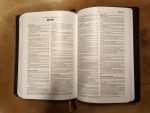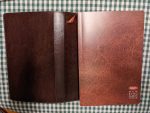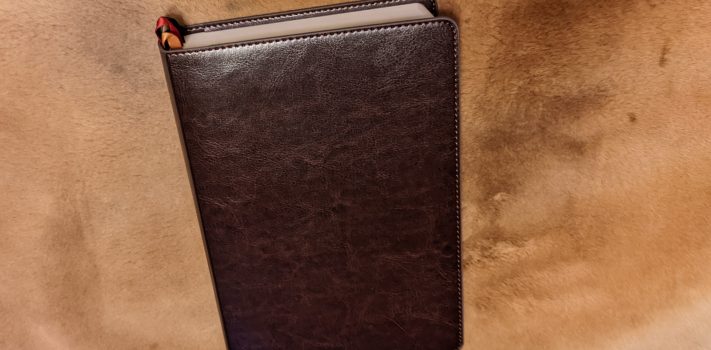Field gear is often subject to a wide variety of weather conditions. Like the Persian mounted couriers made famous by Herodotus, field gear may face snow, rain, heat, and gloom of night among other challenges.
Wildly varying weather conditions can be a special challenge to books in general, and Bibles in particular. That is what makes the Bardin & Marsee Waterproof Bible so interesting for outdoors-folk who carry a Bible as a part of their gear.
The Waterproof Bible is printed on a synthetic paper made from plastic resins and inorganic fillers. You can read it in a rainstorm or a bathtub with no risk of damaging its binding or pages.
Pat Cascio wrote a brief review of Barden & Marsee’s earlier press run of these Bibles for SurvivalBlog back in 2013, but I’d like to describe their current offering, in more detail.
Mr. Robert Bardin of Bardin & Marsee was kind enough to provide me with a copy of the Waterproof Bible recently for testing. Bardin and Marsee is a family operation run by Mr. Bardin, his wife Anna, and their four children.
Three days after Mr. Bardin promised to send the Bible, it arrived USPS Media Mail from Birmingham, Alabama.
Opening the Package
The Bible arrived in a padded envelope within a padded envelope.
The edition I received has a brown, imitation-leather cover. The imitation-leather cover is actually a slip cover that fits over the synthetic paper cover. Three ribbon markers are integrated into the slip cover. These markers are black, red, and gold. Together with the white pages, they can provide a makeshift “Wordless Book” for giving a simple presentation of the gospel. The black represents our sin. All of us have sinned and fallen short of the glory of God. The red represents the blood of Jesus Christ, which cleanses us from all sin. By paying our penalty on the cross, Jesus Christ washes away the sins of those who place their faith in Him with His own blood. The white represents our cleansing when we put our faith in Jesus Christ. We are now clothed with His perfect righteousness. The gold represents our eternal future with Him. We will walk the streets of the New Jerusalem with Him on a pavement of gold as clear as crystal.
The package also contained a “Waterproof Bible” sticker, and six Bardin & Marsee page markers.
 The Waterproof Bible measures 9.25 X 6.25 X 1.5 inches. This is roughly similar in size to my Thomas Nelson Compact Giant Print Bible, which measures 8.25 X 5.5 X 1.25 inches. But the Waterproof Bible consists of only 724 pages, while the Compact Giant Print Bible has 1,426 pages. This is because the synthetic paper of the Waterproof Bible is about twice as thick as the special Bible paper of the Compact Giant Print Bible. In order to get the same number of words on roughly half as many pages, the Waterproof Bible uses 8 point type, while the Compact Giant Print Bible uses what I would guess to be 12 point type. This means that I need to wear my bifocals to read the Waterproof Bible, but not to read the Compact Giant Print Bible.
The Waterproof Bible measures 9.25 X 6.25 X 1.5 inches. This is roughly similar in size to my Thomas Nelson Compact Giant Print Bible, which measures 8.25 X 5.5 X 1.25 inches. But the Waterproof Bible consists of only 724 pages, while the Compact Giant Print Bible has 1,426 pages. This is because the synthetic paper of the Waterproof Bible is about twice as thick as the special Bible paper of the Compact Giant Print Bible. In order to get the same number of words on roughly half as many pages, the Waterproof Bible uses 8 point type, while the Compact Giant Print Bible uses what I would guess to be 12 point type. This means that I need to wear my bifocals to read the Waterproof Bible, but not to read the Compact Giant Print Bible.
Options
The Waterproof Bible is currently available in four translations (KJV, NKJV, ESV, and NIV), six cover options (paper, imitation leather, or four types of genuine leather), in four colors (black, brown, natural, or camouflage), in two portions of Scripture (the entire Bible, or the New Testament, Psalms, and Proverbs).
Preparing the Bible for Use
I began preparing the Bible for use by writing my name on the presentation page. I highly recommend this step to all who acquire a new Bible. This makes it much easier for church staff to find the owner of a misplaced Bible. I feel sorry for all of the lonely Bibles in lost and found that do not bear their owners’ names. They typically languish in lost and found for a year or two, until they are finally taken to a thrift store for donation.
After writing my name in the Bible, I stood it on its spine on a table, opened a few pages at a time beginning from the front and back of the Bible simultaneously, and gradually worked my way toward the middle. I didn’t force the pages open, but just let gravity take them gradually toward the tabletop. This gently and evenly stretched the spine of the Bible without breaking it.
After stretching the spine, I transcribed some opening questions, closing questions, and a chain reference system into the Waterproof Bible. These questions and this chain reference system are inspired by Bill Fay’s Share Jesus Without Fear evangelistic materials. I have described these questions and the chain reference system in my review of the Cambridge Univeristy Press KJV Large Print Bible that was published on SurvivalBlog on May 7, 2021. I have found this material to be a helpful tool as I have shared the gospel with people.
I used a ballpoint pen to write these questions and references in the Waterproof Bible. There was a tendency for the ink from the page upon which I wrote to blot and smear onto the facing page. If I were to go back and do this process over again, I would insert a piece of paper between the Bible pages upon which I wrote and the pages that faced them until the ink had a chance to dry.
After preparing the Bible, I transferred it to the nylon Bible case that I use to carry the Bible from which I am currently having my daily devotions. I systematically read through the Bible each year. The best way to understand the Bible is by consistently reading it in its entirety.
Trial by Fire
A couple of hours after I finished preparing the Waterproof Bible for use, my phone rang. It was my Senior Pastor. He reported that he was ill, and asked me to preach in his place the next day, which was Sunday.
Fortunately, I had taught previously (sixteen years previously) from the passage that we would be focusing on that Sunday. As a result, I had previously studied the passage in some depth. The passage was Ephesians 6:10-20, on the Armor of God.
I was to focus in particular on the belt of truth, the breastplate of righteousness and the preparation of the gospel of peace in Ephesians 6:14-15. I reviewed the passage, prepared some notes, and the next day I preached for the first time from the Waterproof Bible.
I found the synthetic pages of the Waterproof Bible to turn more easily than standard paper. The 8-point font was slightly smaller than I would have preferred, but did not create any problems. All in all, I was pleased with the performance of the new Bible.
Later that morning, I taught the 5th through 8th grade Sunday School class on the imprecatory Psalms. I was blessed that the class was attentive and participated well as we explored a somewhat difficult subject. I was fully satisfied with the performance of the Waterproof Bible in this context as well.
The Freezing Test
I wondered if the synthetic pages of the Waterproof Bible would become brittle when cold. My wife had previously bought me a Waterproof New Testament for Christmas. I decided to use that edition for this potentially destructive testing, since it is less valuable than the full edition of the entire Bible.
I placed the Waterproof New Testament in the chest freezer in our basement. The chest freezer is set to zero degrees Fahrenheit. I left the New Testament in the freezer overnight.
 The next morning, I threw the frozen New Testament onto the concrete floor of the basement. The portion of the binding that first struck the floor shattered on contact. The glue that connected the binding to the rest of the New Testament also failed, so that the binding separated from the rest of the book. I threw the internal pages onto the concrete floor a couple of more times, but they suffered no significant damage as a result of this abuse. So it seems that the binding is more susceptible to cold weather-related damage than the pages.
The next morning, I threw the frozen New Testament onto the concrete floor of the basement. The portion of the binding that first struck the floor shattered on contact. The glue that connected the binding to the rest of the New Testament also failed, so that the binding separated from the rest of the book. I threw the internal pages onto the concrete floor a couple of more times, but they suffered no significant damage as a result of this abuse. So it seems that the binding is more susceptible to cold weather-related damage than the pages.
The Water Test
Next, I placed the New Testament in a bucket of water, and allowed it to soak overnight. This demonstrated that the synthetic material upon which the Waterproof New Testament is printed is lighter than water. It floated quite well.
The New Testament was still floating well the next morning. I removed it from the bucket. The pages were unaffected.
I put the New Testament spine down on a towel, and allowed it to dry. After more than a week of drying, a fine film of moisture was still trapped between the pages. Because the pages are waterproof, they prevent the moisture from evaporating. This moisture does not make the New Testament difficult to read, but it does make the pages somewhat difficult to turn due to the surface tension of the film of water holding the pages together.
Conclusions
The Waterproof Bible definitely is what it says: it is waterproof. It would be a great Bible to read while boating, at the poolside, or out in the rain.
 Extremes of cold and heat are a greater threat to the Bible than water. For instance, instructions on the contents page of the Bible note that the synthetic material upon which the Bible is printed, “is adversely affected by temperatures above 150 degrees Fahrenheit”. This means that you should not leave the Bible on the dashboard of your car in the Arizona sun during the summer. It also means that you should not put the Bible in the oven to get rid of that pesky moisture that has been trapped between the pages since the last time you accidentally dropped it in the swimming pool.
Extremes of cold and heat are a greater threat to the Bible than water. For instance, instructions on the contents page of the Bible note that the synthetic material upon which the Bible is printed, “is adversely affected by temperatures above 150 degrees Fahrenheit”. This means that you should not leave the Bible on the dashboard of your car in the Arizona sun during the summer. It also means that you should not put the Bible in the oven to get rid of that pesky moisture that has been trapped between the pages since the last time you accidentally dropped it in the swimming pool.
My own experiments suggest that the cover and the glue that binds the cover to the rest of the Bible may become brittle at low temperatures, making it susceptible to damage under cold weather conditions.
Keeping these things in mind, the Waterproof Bible is likely to tolerate adverse field conditions better than traditional paper Bibles.
Disclaimer
Bardin and Marsee Publishing was kind enough to provide me with a sample Waterproof Bible for testing and evaluation. I tried not to allow their kindness to interfere with my objectivity, and believe that I have succeeded. I did not receive any other financial or other inducement to mention any vendor, product, or service in this article.










